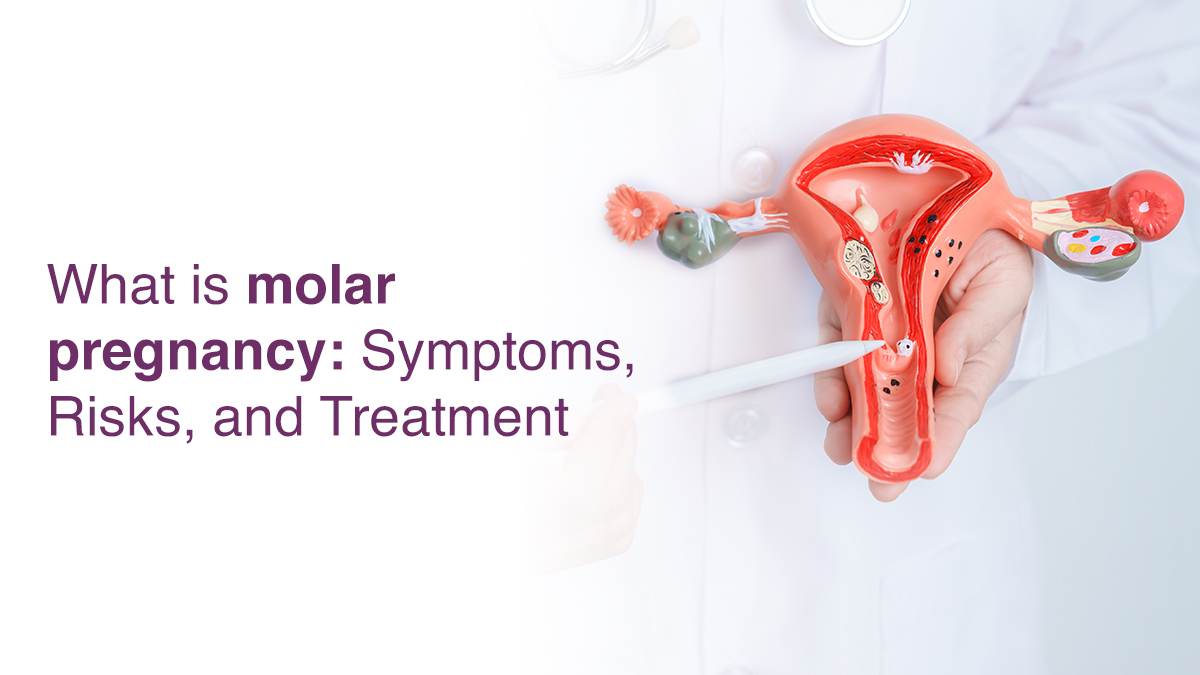A woman’s body changes throughout her pregnancy to grow and accommodate her kid. The process begins when an egg is fertilised by sperm and then attaches to the uterus. Her body adapts to support the baby’s growth as it develops over the course of the months. But occasionally, things don’t work out as expected. In a rare disorder known as molar pregnancy, abnormal tissue forms in the uterus in place of a healthy baby. Early detection is crucial to safeguarding the woman’s health because it can be harmful.
What Is a Molar Pregnancy?
Molar pregnancy is a rare complication that can develop during pregnancy. It involves trophoblasts that are cells that grow abnormally. Usually, these cells develop into the organ that provides nourishment to the developing fetus. The placenta is another name for that organ.
Complete and partial molar pregnancies are the two types of molar pregnancy. The placental tissue swells and seems to develop fluid-filled cysts during a full molar pregnancy. No fetus is present.
Both normal and irregular tissue may be present in the placenta during a partial molar pregnancy. A fetus might exist, but it is incapable of surviving. Miscarriages of the fetus typically occur early in pregnancy. Serious side effects, such as an uncommon type of cancer, can arise from a molar pregnancy. Early treatment is necessary for a molar pregnancy.
Symptoms of Molar Pregnancy
Sometimes, a molar pregnancy has no symptoms, but signs can include:
- Vaginal bleeding in the first trimester
- Brown watery discharge
- Grape-like sacs passing from the vagina
- More frequent or severe nausea and vomiting than typical for pregnancy
- Pelvic pressure or discomfort
- Excessive abdominal swelling for the stage of pregnancy
- High blood pressure (preeclampsia) before 20 weeks
- Anemia (low red blood cell count)
- Extremely elevated levels of hCG hormone
- Ovarian cysts
- Hyperthyroidism (overactive thyroid)
Call your doctor If you experience unusual symptoms during your pregnancy.
Risks and Complications of Molar Pregnancy
Risk Factors:
Maternal age, with a larger chance in those under 15 or over 43, and a history of molar pregnancies, which increases the risk to roughly 1 in 100, are factors that can contribute to molar pregnancy.
Complications:
Complete molar pregnancies are more likely to result in persistent gestational trophoblastic neoplasia (GTN), which can arise if molar tissue persists and grows after excision. Vaginal bleeding may result from high hCG levels, which post-removal signifies GTN. Chemotherapy and, in extreme situations, hysterectomy are available as forms of treatment. Rarely, choriocarcinoma, a malignant GTN type that is usually curable with chemotherapy, may arise and spread.
Diagnosis of Molar Pregnancy
During normal prenatal testing, typically in the first trimester, your healthcare professional will identify a molar pregnancy. Instead of a placenta, an ultrasound of your uterus frequently reveals many fluid-filled sacs. Your uterus typically contains no embryo or fetus, although occasionally, pregnancy tissue is still there.
Moreover, hCG levels in your blood can also be measured by your healthcare practitioner. hCG is produced throughout pregnancy by a healthy placenta. To verify a pregnancy, at-home pregnancy tests analyse this hormone in your urine. High quantities of hCG are produced during molar pregnancies. These elevated amounts can be found by a blood test, which may indicate the occurrence of a molar pregnancy.
Treatment Options for Molar Pregnancy
To avoid difficulties, the abnormal tissue in the uterus is removed as part of the treatment for molar pregnancy. This is typically accomplished by carefully removing the tissue using a process known as dilatation and curettage (D&C). Medication may be utilised in certain situations to aid in the tissue’s expulsion. Human chorionic gonadotropin (hCG) levels must be regularly checked after therapy to make sure no molar tissue is left behind and to identify any ongoing growth. Chemotherapy frequently works if persistent gestational trophoblastic neoplasia (GTN) develops. A hysterectomy, or removal of the uterus, may be considered for full therapy in rare, severe situations.
Preventive Measures and Follow-Up Care
Early prenatal care and knowledge of risk factors, such as the mother’s age and previous molar pregnancies, can help in early detection as part of molar pregnancy prevention strategies. For high-risk people, routine monitoring and ultrasound to check for molar pregnancy are crucial. Close monitoring is essential after a molar pregnancy in order to identify any residual molar tissue. This requires checking hCG levels routinely to ensure they return to normal. To allow for careful monitoring, patients are frequently recommended to forgo pregnancy for six to twelve months. To avoid such problems, more medication, including chemotherapy, might be needed if hCG levels stay high.
When to Seek Medical Advice?
Unusual pregnancy symptoms such as vaginal bleeding, brown watery discharge, intense nausea, pelvic pain, or rapid stomach swelling should be taken seriously since they may indicate a molar pregnancy. If you’ve had a molar pregnancy before, inform your doctor early in any subsequent pregnancies for thorough monitoring. Regular follow-up care is essential after therapy; if symptoms worsen or your hCG levels stay elevated, talk to your doctor because additional treatment might be required.
Conclusion
Early prenatal care, a healthy lifestyle, genetic counselling, and routine checkups may lower the risk or aid in the early detection of molar pregnancy. If you notice any symptoms, then book an appointment at your nearest Oasis Fertility and have an in-depth discussion with our fertility specialists. Additionally, you can also get prompt assistance by calling 1800-3001-1000 or using our live chat facility for more information.

